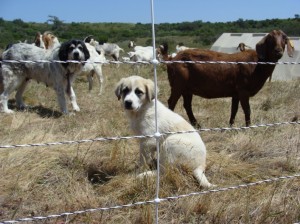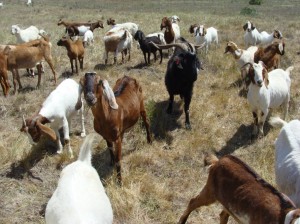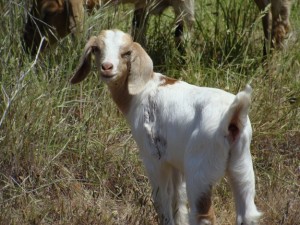PREVIEW PAGE
Holistic Grazing at Graniterock's Santa Cruz Sand Plant
Posted by Alex Simons on Mar 18, 2015
On April 22nd,Graniterock welcomed a herd of goats and their kids along with the guard dog “Baby” and her puppies “in training” at the Santa Cruz Sand Plant. The goats are being used as part of a holistic management plan to decrease the amount of non-native grasses in the area and encourage growth of natives.

The goats graze an area called Sandy Flat, which was previously a mining location at the Santa Cruz Sand Plant. During the original reclamation, the valley was seeded with Santa Cruz County’s 1990 Best Management Practice erosion control seed mix to revegetate the area as grassland. Unfortunately the seed mix contained a handful of non-native invasive grasses that quickly became established in the small valley and out-competed any native grasses that might have grown there.
Graniterock’s aim is to enhance Sandy Flat by encouraging the growth of native grasses and controlling non-natives with holistic management techniques. Timing is critical when it comes to grazing. Other important factors that must be considered for a successful grazing regime include grazing goals, species of goat, weather, and flowering and seeding times of plant species.
Our first step was to monitor non-native grasses throughout the winter and early spring in order to determine when they were starting to produce seed. It took a certain amount of prediction to decide whether we were going to have a second winter rainy season or an early spring, but conversations with botanists throughout Santa Cruz County suggested that an early spring was in order for 2013.
Livestock Landscape Solutions owner Ben Long supplied goats to do the grazing work. Long met with Graniterock Environmental Specialist Alex Simons to determine timing of grazing, the breed and number of goats to be used and what the duration of the project should be for optimum results. Having both the land owner and grazer discuss project details is crucial to the success of such a project. The grazer knows what his herd is capable of doing and the owner is able to specify land management goals. Together they agreed to implement the grazing project before non-native grasses could produce viable seed. Having the goats graze before the grasses could produce seed prohibited the spread of unwanted seed.

The method they decided on was to have the goats eat in small fenced enclosures for two to three days before moving on to the next enclosure. The goats leave behind the stubble of non-native plants stripped of their seed. Before and during grazing, native grass seed are spread within the cell, including California poppy, meadow barely, tomcat clover, sky lupine, purple needle grass, California brome, and blue wild rye.
In October 2012, Ben’s herd was hired to graze ponds within Graniterock’s Habitat Conservation Area, a 10.5 acre protected breeding and foraging ground for the federally endangered California red-legged frog. The herd was hired to graze the tule within the ponds to maintain frog breeding habitat. By spring an extra benefit was noticed; within the enclosures, the goats had eaten native sky lupine and carex seed and that had encouraged more to flourish around the pond. These successful results sparked the idea to use goats to graze and use native seed to enhance the grassland area.
While the goats are eating and walking through their enclosure, they eat and press scattered seed into the ground and create fertilizer for the seed. Following next winter’s rains, Sandy Flat vegetation will be monitored for native species and to determine overall success of the grazing project.With each grazing project, Sandy Flat will be returned over time to California grassland filled with native grasses and forb species. With every native grass or forb that comes back, Graniterock expects to see more native pollinators like birds, animals and insects follow to make a new home.
Are you interested in having the goats of Livestock Landscape Solutions graze your site?Contact Ben Long at 650-479-GOAT
Back to all Blogs

